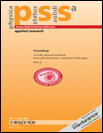A comparison of pores in silicon and pores in III–V compound materials
Abstract
This paper compares the morphologies of porous silicon and porous III–V compounds and discusses their growth mechanisms. Looking into the fine structure of pores, in silicon (meso)pores with intercalating octahedra are prevalent, while in III–V compounds chains of tetrahedra are observed. The anisotropic properties of pore growth in all materials can be understood considering the role of surface states in the band gap and the anisotropy of the passivation of these states which leads to an “aging” effect of the surface. In III–V compounds, and for the first time in silicon, the strong interaction of pores during their growth has been found. In InP as well as in silicon these interactions lead to self-induced diameter modulations. To achieve this effect in Si requires the etching conditions to be comparable to those in the III–V compounds.




